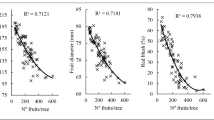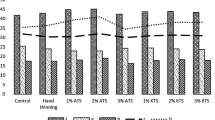Abstract
‘Elstar’, the most widely grown apple variety in the Netherlands, requires adequate fruit thinning to obtain regular bearing and the commercially desired fruit size and fruit quality. During several years studies have been carried out to look for alternative thinning methods to replace carbaryl, an insectide which also induced thinning when applied to young fruitlets, but that is no longer registered in the Netherlands. During recent years research on apple thinning has focused on the use of ammonium thiosulphate (ATS) as a flower thinner combined with 6-benzyladenine (BA) as a fruitlet thinner. This paper reports on a trial in which the fruit thinning efficacy of this combined treatment with ATS and that of BA on its own were evaluated. In addition, the use of slaked lime (Ca(OH)2) to cover the leaves and reduce leaf photosynthesis at three different times during fruitlet development was tested, alone or in combination with an application of BA. The best chemical thinning treatment of this trial was the combination of 3 applications of ATS during flowering followed by BA at a fruit size of 13.8 mm. This treatment gave 82% of the thinning necessary to obtain the target fruit load. This treatment also effectively improved fruit size distributions, fruit colour and internal fruit quality. Slaked lime did not thin ‘Elstar’ effectively, most probably because it did not cause sufficient reduction of light interception by the canopy.
Zusammenfassung
‘Elstar’, die wichtigste Apfelsorte in den Niederlanden, benötigt regelmäßige Fruchtausdünnung, um einen regelmäßigen Ertrag sowie Früchte der gewünschten Größe und Qualität zu produzieren. Seit mehreren Jahren wird nach einem Ersatz für das Insektizid Carbaryl gesucht, welches eine gute Ausdünnungswirkung auf junge Früchte besitzt, aber in den Niederlanden nicht mehr genehmigt ist. In jüngerer Vergangenheit hat sich die Forschung der Apfelausdünnung auf Ammoniumthiosulfat (ATS) als Blütenausdünner und die Kombination von ATS mit 6-Benzyladenin (BA) als Fruchtausdünner konzentriert. Die vorliegende Arbeit berichtet über Versuche zur Fruchtausdünnungsleistung dieser beiden Produkte im Vergleich mit der von BA allein. Zudem wurde versucht, die Photosyntheseleistung der Blätter an drei verschiedenen Zeitpunkten der Fruchtentwicklung durch einen Belag mit Löschkalk herabzusetzen, allein oder in Kombination mit BA. Die beste chemische Ausdünnung dieser Versuche war eine Kombination aus 3 ATS-Behandlungen während der Blüte, gefolgt von einer BA-Spritzung bei einer Fruchtgröße von 13,8 mm. Diese Behandlung ergab 82% des zum Erreichen der Zielfruchtzahl nötigen Ausdünnungseffekts und führte zu einer effektiven Verbesserung der Fruchtgrößenverteilung, Fruchtausfärbung und internen Fruchtqualität. Löschkalk führte zu keiner effektiven Fruchtausdünnung von ‘Elstar’; wahrscheinlich wurde der Lichtdurchlass nur unzureichend verringert.
Similar content being viewed by others
Introduction
‘Elstar’, the most widely grown apple variety in the Netherlands, requires adequate fruit thinning to obtain regular bearing and the commercially desired fruit size and fruit quality. For many years carbaryl has been the most used chemical thinner used to thin ‘Elstar’ trees that set more than the target fruit load of 100 fruits per trees for a standard plantation with a tree density of 3,333 trees/ha (3.00 m × 1.00 m). In recent practical field trials ammonium thiosulphate (ATS), ethephon, and 6-benzyladenine (BA) were shown to be effective thinning agents for ‘Elstar’ (Maas & Peeters 2002; Maas & van der Steeg 2002). During recent years thinning trials have been focused on the use of ATS during flowering followed by BA at approx. 10–12 mm fruitlet diameter. In addition trials have been carried out to evaluate the possible use of suspensions or dyes to cover the leaves and reduce light interception. The aim of these trials was to enhance natural fruit drop by temporary reduction of photosynthesis (Fig. 1), an approach which has been demonstrated to thin ‘McIntosh’ apples when the trees were exposed for a few day to low light levels by the use of shade nets (Byers 2002).
Results
In spring 2006 the trees used for the trial had on average 245 flower clusters each (Table 3). In the hand-thinning treatment the average number of fruits/tree removed by hand to obtain the target fruit load of about 100–110 fruits was 164. At harvest, the mean fruit number of the hand-thinned trees was 119 fruits/tree, just a few fruits above the target fruit load. Final fruit set of the hand-thinned trees was 55 fruits/100 flower clusters.
Trees treated with ATS and BA (treatment 2) yielded on average 148 fruit/tree, fruit set at harvest being 69 fruits/100 flower clusters. Thus, compared to hand thinning, the use of ATS + BA reduced the requirement for hand thinning by about 82%. Using BA only (treatment 3), the trees produced on average 182 fruits, i.e. BA reduced hand-thinning requirement by 62%. With 91 fruits/100 flower clusters, fruit set at harvest significantly exceeded (1.6 times) that of the hand-thinned trees. Treatment with slaked lime (Ca(OH)2) 4, 5 or 6 weeks after full bloom yielded about 260 fruits per tree, with a final fruit set of ca. 124 fruits/100 flower clusters. Combination of slaked lime and BA slightly reduced the number of fruits per tree and number of fruits/100 flower clusters to about the same level of the treatment with BA only.
Total fruit yield at harvest varied between 20.8 kg/tree for the hand-thinned trees and about 31 kg/tree for the trees treated with slaked lime. The combination of slaked lime and BA did not significantly affect yield, but increased the average fruit weight from ca. 120 g (slaked lime only) to ca. 146 g (slaked lime + BA). The highest average fruit weight (181 g) was obtained for the trees treated with ATS and BA, but did not significantly differ from that of the hand-thinned and BA-treated trees.
Size grading of the apples (Table 4) resulted in the highest percentages of fruits with a diameter above 70 mm and highest size index for the hand-thinned trees and trees treated with ATS + BA. Treatment with BA only resulted in a slightly, but not statistically significant, lower percentage of fruits above 70 mm. The size index of these fruits was also quite similar to those of the fruits of the hand-thinned and ATS + BA treated trees. Trees treated with slaked lime only produced the smallest fruits. Combination of slaked lime and BA resulted in a fruit size distribution similar to that of trees treated with BA only.
Sorting out the fruits on basis of the amount of blush colour (Table 5) demonstrated that hand thinning resulted in the highest colour index and highest percentage of fruits with more than 75% of blushed skin area. On average, fruits from trees treated with ATS + BA had a slightly lower colour index and percentage of fruits more than 75% blush area, but the difference with the hand-thinned trees was not statistically significant. Blush colour of the BA-treated trees was significantly less than that of the hand-thinned and ATS + BA treated trees. However, fruit from the BA-treated trees had much more blush colour than the fruits of trees treated with slaked lime or slaked lime + BA.
Fruit background colour, firmness, sugar, starch and acid content differed most distinctly between the trees thinned by hand, ATS + BA or BA and those treated with slaked lime, a product that hardly produced any thinning effect (Table 6). The levels of sugars, acids and starch were positively related to the degree of thinning. Thus, the highest values were observed in fruits of trees thinned by hand, followed by trees treated with ATS + BA and BA only. The lowest values were observed for trees treated with slaked lime only.
Conclusions
The best chemical thinning treatment of this trial was the combination of 3 applications of ATS during flowering followed by BA at a fruit size of 13.8 mm. This treatment gave 82% of the thinning necessary to obtain the target fruit load. This treatment also effectively improved fruit size distributions, fruit colour and internal fruit quality. Slaked lime, applied with the aim of enhancing fruit drop by reduction of light interception by the leaves, did not thin Elstar effectively.
References
Byers RE (2002) Influence of temperature and darkness on Apple fruit abscission and chemical thinning. Journal Tree Fruit Production 3:41–53
Maas F, Peeters J (2002) Elstar dunnen met ATS of ethrel. Fruitteelt 92(15):14–16
Maas FM, van der Steeg PAH (2002) Chemische dunning Elstar. Rapport nr. 2002–2028, Praktijkonderzoek Plant & Omgeving, Sector Fruit, Randwijk
Acknowledgements
This research was financed by the Dutch Product Board for Horticulture (Productschap Tuinbouw).
Author information
Authors and Affiliations
Corresponding author
Rights and permissions
Open Access This is an open access article distributed under the terms of the Creative Commons Attribution Noncommercial License ( https://creativecommons.org/licenses/by-nc/2.0 ), which permits any noncommercial use, distribution, and reproduction in any medium, provided the original author(s) and source are credited.
About this article
Cite this article
Maas, F. Ausdünnungsstrategien für die Apfelsorte ‘Elstar’ – Erfahrungen mit Ammoniumthiosulfat, Calciumhydroxid und Benzyladenin. Erwerbs-Obstbau 49, 101–105 (2007). https://doi.org/10.1007/s10341-007-0042-z
Received:
Accepted:
Published:
Issue Date:
DOI: https://doi.org/10.1007/s10341-007-0042-z






